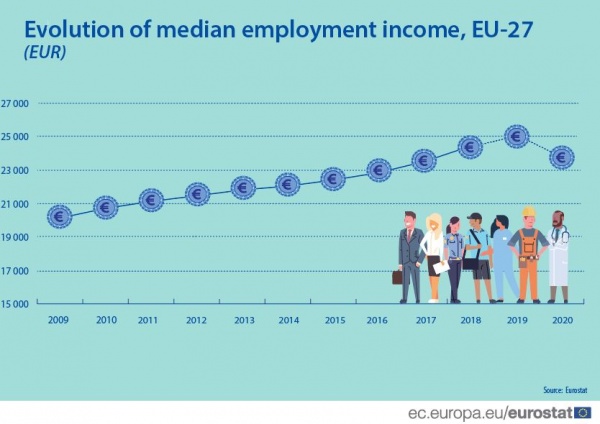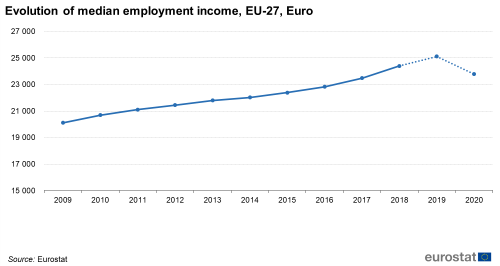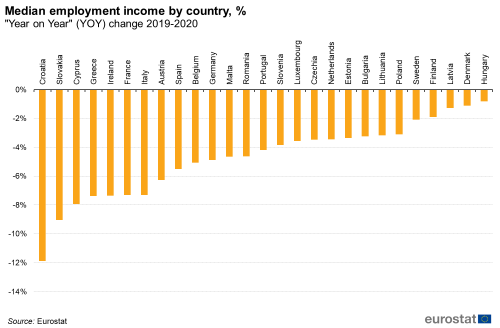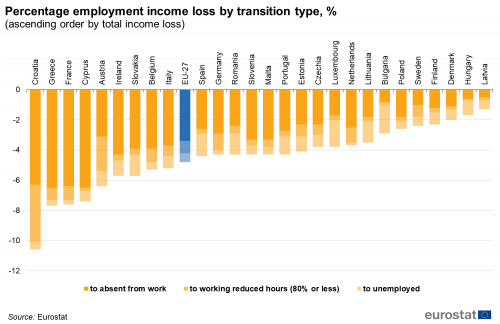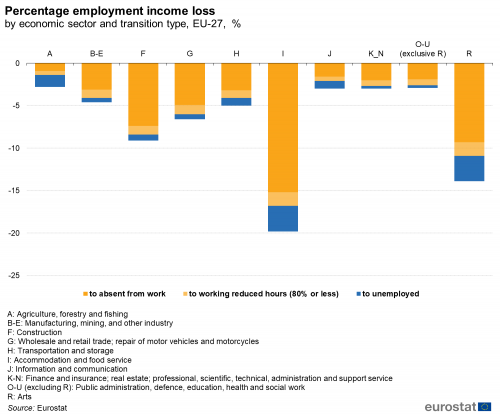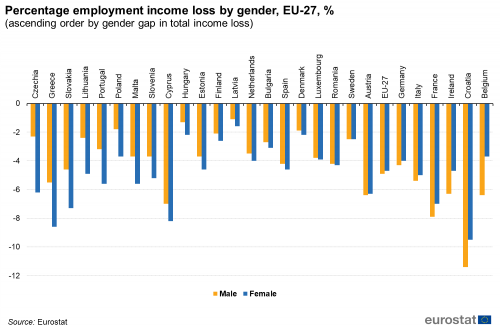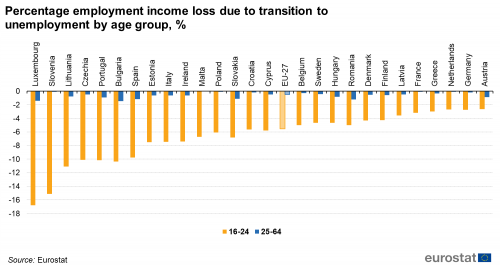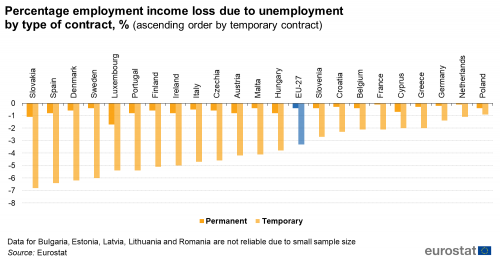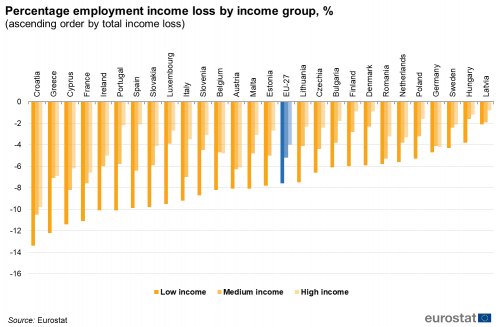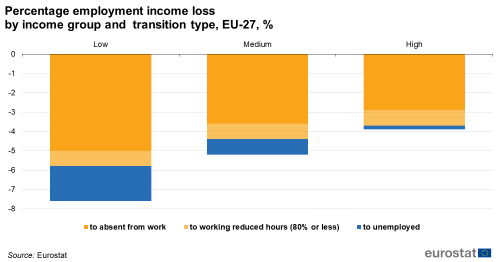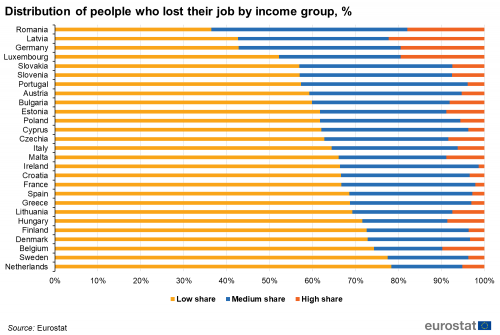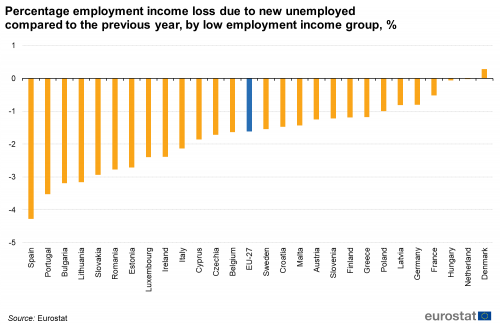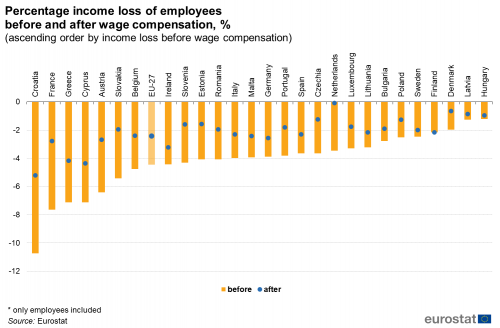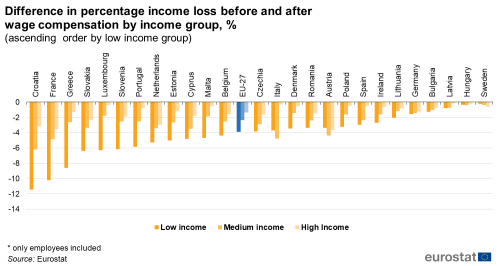Impact of COVID-19 on employment income - advanced estimates
Data extracted in October 2020.
No planned article update.
Highlights
The total employment income at EU level decreased by -4.8% in 2020, with the largest decreases due to absences and reduced hours.
COVID impact on income: wage compensation schemes mitigated the income loss to about -2% at EU level in 2020.
The current Covid-19 pandemic crisis and the economic shutdown due to sanitary measures led to an unprecedented rise in the number of workers absent from work or working reduced hours[1] and an increased number of jobs lost. This article presents the first results of a nowcasting exercise on the employment income losses in 2020 and their distribution.
In general, the estimated income losses for workers before government compensation at EU level, around -5 % of the total earnings, are very unequally spread between countries and particularly strong for the most vulnerable sub-groups of the working population[2]. These unequal effects on the labour market are mitigated by temporary policy measures introduced in all countries in order to support household incomes and workers most affected by the pandemic.
Throughout the paper, employment income losses are decomposed according to three types of transitions: (1) workers lose their job or their contract is not renewed; (2) workers remain employed but they enter temporary layoffs; (3) workers remain employed but they work only a fraction of their usual hours. The losses are further distributed by vulnerable sub-groups most likely to experience higher income losses and an increased risk of poverty. Finally, the impact of short-term work schemes activated by national governments to address the Covid-19 economic challenges, in particular, policies to preserve jobs (wage compensation schemes) is simulated via a tax-benefit model .
All figures provided are part of the experimental statistics produced by Eurostat in the frame of advanced estimates on income inequality and poverty indicators. However, this study departs from the standard flash estimates framework : it focuses only on income from work and it relies largely on models and estimations. An important input is the administrative data collected by Eurostat on the number of beneficiaries of different wage compensation schemes[3]. The results refers to the yearly change 2019-2020 but the estimates do not account for the second wave of sanitary crisis in term of absences and wage compensation schemes. For more details on the labour findings, please see also the article COVID-19 labour effects across the income distribution.
The population of interest is the working population, either employees or self-employed (age 16-64) and income figures are yearly. They include gross wages and self-employment income.
Full article
A sharp decrease in the median employment income
The estimated decline in the median[4] employment income (before government compensations) at EU level reaches -5.2 %.
Figure 2 presents the evolution between 2019-2020 by country. The year on year change ranges from -12 % to -1 % with the largest income losses in Croatia, Slovakia, Cyprus, Greece and Ireland.
Largest losses in employment income are due to absences from work
The estimated income loss for workers is simulated according to three types of labour transitions that workers can undergo: to unemployment, transition to absent or working reduced hours[5] while remaining employed. The two latter forms are specific to the current crisis and are estimated based on the economic shutdown in the second quarter of 2020[6].
The total employment income at EU level decreases by -4.8 %, with the largest decreases due to absences and reduced hours. According to Eurostat estimations[7] the number of people absent or working reduced hours in the middle of the lockdown in April range across countries from 1 % up to 50 % in the most affected countries. Moreover, in about half countries (12) the share of people working 80 % or less hours is above 20 % while in another 11 countries this share ranges between 11 % and 20 %. This translates into a 4.2 % loss in employment income at EU level[8], due to absences and working reduced hours. The highest total income losses are estimated for Croatia (10.6 %), Greece (7.7 %), France (7.6 %) and Cyprus (7.4 %). The decrease in income due to job losses is much less pronounced, with higher decreases registered in Bulgaria (-1.9 %), and Luxembourg (-1.8 %).
Income loss due to absences has strong sectorial dimension, with food and accommodation registering losses of almost 20 %
The Covid-19 crisis and people working zero or reduced hours is highly dependent on the sector and the exposure risk at country level is proportional to the weight of the sectors affected in the economy.
The percentage of people absent for the sector “food and accommodation” reached staggering numbers in April with half of the countries registering more than 50 % of workers absent or in a temporary government support scheme[9]. Moreover, for workers in this sector the duration of absence is longer so they are likely to lose a larger share of their yearly income[10]. Figure 4 shows the percentage of income losses by sector and decomposed by transition type. In the sectors “food and accommodation” and “arts and entertainment” the income losses due to absence or reduced hours reach -16.8 % and -10.9 % respectively. The losses due to unemployment transitions are also the highest in sector "food and accomodation", at around -3 %.
Income losses are highly concentrated in vulnerable sub-groups...
The highest decreases due to job losses across EU are noted for temporary workers and the young employed (aged 16-24). The estimated income loss is more than two times higher for young workers (16-24) than for adults workers (25-65). Women are likely to be more affected, mainly due to a larger prevalence of women in the affected sectors.
Women have higher income losses in about half of the EU countries with the largest differences in Czechia, Greece, Slovakia, Lithuania and Portugal.
When focusing on income losses due to unemployment, the differences are even more pronounced. Extending the analysis to country level, it is clear that the young employed were largely more affected by jobs losses, possibly due to the high number of young employees working in sectors strongly affected by the Covid-19 lockdowns. The employment income among young people decreased in all countries. The sharpest decreases were reported by Luxembourg, Slovenia, Lithuania, Bulgaria, Portugal and Czechia (more than -10 pp for all seven), while the lowest decreases were registered in Austria, the Netherlands and Germany (less than -3 % for all three).
The employment income among temporary contracts decreased in all countries due to transitions to unemployment consistently more compared with the permanent ones. The sharpest decreases were reported by Slovakia, Spain, Denmark and Sweden (– 6 pp or above for all four), while Poland showed the smallest decrease and also the smallest gap compared with permanent contracts (both below -1 pp), followed by the Netherlands and Germany (less than -1.5 pp for both).
…and skewed towards the left of the distribution with low wage earners having losses 3 to 6 times larger for half of the countries
Finally, income losses linked to the lockdown measures across three main employment income groups are assessed: low-income earners comprise individuals in deciles 1, 2 and 3; the middle group comprises deciles 4, 5, 6, 7; deciles 8, 9 and 10 define the high-income category.
In Figure 9 it can be noted that in all countries the decrease in percentage term is higher for the low income group. The income loss is 3 to 6 times higher for the low income group than their peers in the high income group in half of the EU Member States with the highest differences for Portugal, Spain and Luxembourg (up to 8 pp).
Figure 10 shows the percentage loss at EU level for the three income groups decomposed by the type of transition. Low wage earners are more likely to be affected by unemployment transitions and therefore not benefit from the safety net put in place with the wage compensation schemes. They have also a larger share of income losses due to unemployment.
Even if, in general, the reduction in income due to unemployment has a low share in total income loss, the distribution is highly unequal. Figure 11 shows that the distribution of losses is skewed towards the left with the low earners having a prevalence higher than 30 % in total workers that lost their job in 2020 in all countries.
Taking a closer look at the low-income earners, it can be noted that income losses due to transition to unemployment led to decreases in all countries, apart from Denmark. The sharpest decreases were reported by Portugal and Spain (-3.5 % and -4.3 % respectively), while the lowest decreases were registered in the Netherlands and Hungary (less than -0.1 % for both).
Wage compensation schemes mitigated the loss of employment income
EUROMOD is used to simulate the impact of these discretionary policy measures exceptionally introduced or activated by national governments to address the Covid-19 economic challenges, in particular, policies to preserve jobs (wage compensation schemes) and income support to the self-employed.
In EUROMOD, there are 25 EU Member States[11] with a wage compensation scheme for employees implemented to mitigate the loss of employment income (Figure 13). These schemes provide a monetary compensation to employees absent from work due to Covid-19 restrictions. The compensation is paid solely by the state or both by the state and the firm (10 countries[12] have a compensation paid by the firm simulated in EUROMOD). Employees receive either a fixed amount (Greece, Croatia, Malta) or a percentage of their employment income or net earnings (Austria, Ireland) that replaces at least partially their employment income during the period they are unable to work. This percentage is often subject to a minimum and/or maximum threshold (Belgium, Cyprus, Estonia, Spain, France, Luxembourg, Latvia, Portugal, Slovenia and Slovakia). The share of monetary compensation that replaces the original employment income can be calculated as the replacement ratio[13] . This ratio takes the value of 1 in case of full replacement.
Compensation schemes contributed to mitigate the income loss in all EU Member States. Figure 13 shows the percentage loss in employment income between 2019 and 2020, before and after monetary transfers. To a general extent, the measures put in place had an important effect to attenuate the impact of the crisis. In the EU, the overall income loss passed from above -4 % to about -2 %. In about 15 countries the wage loss was reduced by half. Countries such as Croatia, France, Austria, and Slovakia and the Netherlands experienced the highest reductions in income loss in the employment sector, due to the compensation schemes.
The loss of employment income is not fully mitigated because: 1) the wage compensation schemes do not fully replace the original employment income of individuals in this scheme or 2) the loss of employment income is due to unemployment and unemployment benefits are not included in this chart.
It is relevant to highlight that wage compensation benefits follow a progressive distribution along the income groups for most of the European countries. The following chart reports the difference between the yearly income loss before and after the compensation schemes, broken down by income group. The purpose of this chart is twofold: on one hand, measuring the reduction of the income loss due to the wage compensation (this reduction is given by the difference in the percentage income loss 2019-2020 before and after benefits); and on the other hand, analyzing the impact of these schemes at different points of the income distribution.
For most of the European countries, it is evident that the low income group receives the highest share of wage loss compensation. Due to wage compensation, Croatia, France, Greece, Luxembourg, Slovenia and Slovakia experienced a relevant attenuation of the income losses for low earners, from about 6 to more than 10 points. In a few countries, such as Austria, Germany and Bulgaria, no significant differences can be observed among the income groups, concerning the way in which the benefits have been transferred.
At this stage the simulation of the compensation schemes for the self-employed is not included in calculations due to lack of complete data. The microsimulation of monetary support for the self-employed often requires some eligibility criteria (e.g. individual loss of self-employment income) that are not available and therefore simulations are less reliable.
Conclusions
The current crisis is causing a labour market shock with a large impact on the earnings of the working population due to both an increased number of jobs lost and a sharp drop in working hours. Without any government compensation, the estimated income loss for EU workers is around -5 % of their total earnings. This loss is largely due to the employed peoples that were absent from work or working reduced hours. The overall effect at country level is likely to depend on the sectorial structure within the country. Countries relying more on tourism seem to have the highest decrease in income. In particular, the sector most affected is food and accommodation registering losses of almost 20 %.
The income loss due to unemployment seems to be concentrated on a few vulnerable sub-groups, such as the young and temporary workers. It is generally skewed towards the left of the distribution with low wage earners having losses 3 to 6 times larger than high wage earners for half of the countries.
Wage compensation schemes mitigated the loss of employment income. These measures attenuated the reduction of employment income between -1 % and -5 %. For many countries the low-income group receives a highest share from wage compensation schemes.
Feedback
To help Eurostat improve these experimental statistics, users and researchers are kindly invited to give us their feedback by email
Data sources
The data used in this report is based on Eurostat estimations. For microsimulation, the information set that entered includes the EUROMOD microsimulation model combined with the latest EU-SILC users' database (UDB) microdata file and/or national SILC microdata available at the time of production. This is enhanced with the latest information on labour from the reference period (2020) – the quarter 2 Labour Force Survey (LFS).
EU-SILC further information
- Income, social inclusion and living conditions
- EU statistics on income and living conditions (EU-SILC) methodology
EUROMOD, the European Union tax-benefit microsimulation model, is maintained, developed and managed by the Institute for Social and Economic Research (ISER) at the University of Essex and the Joint Research Centre (JRC) in the European Commission, in collaboration with national teams from the EU Member States.
EU-LFS further information For more in-depth information on EU Labour Force statistics in 2020 that were used in our estimations please consult the below links:
Context
In the current extraordinary context of the Covid-19 pandemic and the related lockdown, it becomes essential to provide earlier information to enable policy makers to assess the first effects on the income distribution in 2020.
All figures provided are part of the experimental statistics produced by Eurostat in the frame of advanced estimates on income inequality and poverty indicators. This is a second article that assesses the effects of Covid-19 on the income distribution. It presents the first estimates on the evolution of employment income based on the simulation of the labour market impact but also of policy measures put in place by governments in order to support households’ income and workers most affected by the pandemic. For the labour data it combines both survey data on labour market evolution from LFS and administrative data collected in Eurostat on the number of beneficiaries of short time work schemes.
Direct access to
See also
Dedicated section
Methodology
Nowcasting methodology in the context of COVID-19
EUROSTAT is usually releasing the flash estimates on the yearly change of the income indicators year N in July/September year N+1. In the current context, it was considered important to release preliminary estimations on the COVID-19 effects on the income distribution already in 2020. The current article contains estimates for employment income, both wages and self-employment, on which more information is available at the moment.
It is also important to note that while the study is still based in broad terms on microsimulation, the standard nowcasting methodology is redeployed in the COVID-19 context based on a series of adaptations and model assumptions. Thus, the level of uncertainty is higher than for the standard flash estimates given the use of incomplete data (second wave is not taken into account in the estimations) and of forecasting techniques in the model. Data presented should be interpreted in terms of general trends and magnitude and precise figures should not be overemphasised.
An important advantage of the current methodology of nowcasting is that it incorporates in the simulation detailed microdata on the two main impacting factors:
- the effects on the labour market and particular workers at risk due to the COVID-19 economic shutdown and the reduction of the economic activity.
- the impact of temporary policy measures introduced in different countries in order to support households’ income and workers affected by the COVID-19 economic shutdown. The use of a tax-benefit microsimulation model is essential in current conditions.
This allowed both decomposing the simulations of income losses main types of labour transitions and distributing across different sub-groups of the working population.
For more details please see here
Visualisations
Notes
- ↑ https://ec.europa.eu/eurostat/documents/2995521/11410470/3-08102020-AP-EN.pdf
- ↑ For more details on indicators and methodology, please see here
- ↑ https://ec.europa.eu/eurostat/documents/10760954/11071228/Job_benefiting_from_Covid19_governmental_support_measures.xlsx
- ↑ Median at EU level is calculated as an weighted average of the national median values expressed in EUR
- ↑ Less than 80 % of the usual hours worked
- ↑ The second wave and the related reduction of economic activity in the fourth quarter of 2020 is not considered in the current analysis
- ↑ They are based on administrative and survey data
 Targets
Targets
- ↑ For specific countries (e.g. Spain, Italy, Poland) survey data show a much larger number of people absent from work than the number of beneficiaries used from the administrative data on short-term work schemes. In these cases it can be considered that the employment losses might be underestimated
- ↑ Data available in
 Targets
Targets
- ↑ The observation period is from March to June so these figures do not include simulations for the second wave in the last quarter of 2020
- ↑ EUROMOD does not simulate the wage compensation scheme in the Netherlands, because employees will continue to receive 100 % of their original wage even if in monetary compensation. Finland has been excluded from the chart due to a specific difference with the other countries. Compensation schemes are not in place for employees. Temporary laid off employees can apply for earnings-related unemployment benefit if they are members of an unemployment fund and meet a specified work requirement. Otherwise, they can apply for unemployment benefit from the Kela (The National Social Insurance Institute).
- ↑ Austria, Bulgaria, Czechia, Denmark, Estonia, Lithuania, Poland, Portugal, Sweden, Slovenia
- ↑ Caveat: it should be noted that in countries where a minimum threshold is applied, EUROMOD could over-simulate the replacement income for individuals with low incomes (e.g. employees earning below minimum wage). Sometimes not all eligibility criteria can be simulated in the data
